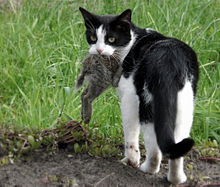46:, is when a generalist predator increases its predation pressure as a result of the introduction of a substitute prey. Hyperpredation has been proven, for instance, in lab settings using two hosts and a parasitoid wasp. Prey that require more handling time than they are worth in terms of nutritional value leads to hyperpredation. In severe circumstances, predators that fed on such prey went extinct. Introduced
20:
94:
Theoretical research indicates that this increased predation may be sufficient to have a demographic impact on prey populations. The empirical data on hyperpredation that are now available are only applicable to situations where the introduction of a feral prey led to an overexploitation of the local
384:
78:(which had inhabited the islands due to DDT wiping out the more territorial Bald eagle population) began preying heavily on the alien species. Another prey on the islands, the
345:
247:"Reversible frequency-dependent predation of a puffer, Takifugu niphobles (Pisces: Tetraodontidae), related to spatial distribution of colour-polymorphic prey"
346:"Local feeding specialization of the red fox ( Vulpes vulpes ) in response to eastern cottontail ( Sylvilagus floridanus ) introduction (NW Italy)"
82:, nearly went locally extinct due to the predation pressure from the golden eagles. These incidents happened in the
83:
124:
383:
Roemer, Gary W.; Coonan, Timothy J.; Garcelon, David K.; Bascompte, Jordi; Laughrin, Lyndal (November 2001).
385:"Feral pigs facilitate hyperpredation by golden eagles and indirectly cause the decline of the island fox"
95:
prey. The most common cause of hyperpredation is apparent competition between the native and alien prey.
449:
396:
162:
51:
119:
511:
430:
276:
227:
47:
506:
477:
469:
422:
365:
326:
318:
268:
219:
178:
501:
461:
412:
404:
357:
310:
258:
209:
170:
16:
Increased predation pressure by a generalist predator when a new prey species is introduced
129:
400:
166:
495:
314:
263:
246:
174:
75:
55:
434:
280:
19:
295:
231:
114:
150:
151:"Patterns and causes of extinction and decline in Australian conilurine rodents"
465:
408:
361:
79:
71:
473:
426:
369:
322:
272:
223:
182:
109:
481:
344:
Balestrieri, Alessandro; Remonti, Luigi; Prigioni, Claudio (2006-03-10).
330:
104:
296:"Predation, apparent competition, and the structure of prey communities"
417:
59:
32:
214:
197:
18:
24:
28:
23:
Hyperpredation has been recorded in an ecosystem involving a
198:"Apparent competition structures ecological assemblages"
448:Zhang, Jimin; Fan, Meng; Kuang, Yang (2006-09-01).
62:being their main predator causes hyperpredation.
8:
196:Bonsall, M. B.; Hassell, M. P. (July 1997).
416:
350:Hystrix, the Italian Journal of Mammalogy
262:
251:Biological Journal of the Linnean Society
213:
141:
7:
58:, as a result this along with the
14:
450:"Rabbits killing birds revisited"
264:10.1111/j.1095-8312.2003.00276.x
245:SHIGEMIYA, YUSUKE (2004-02-06).
149:Smith, A.P.; Quin, D.G. (1996).
303:Theoretical Population Biology
294:Holt, Robert D. (1977-10-01).
1:
315:10.1016/0040-5809(77)90042-9
175:10.1016/0006-3207(96)00002-x
528:
84:California Channel Islands
466:10.1016/j.mbs.2006.01.004
409:10.1017/S1367943001001366
389:Animal Conservation Forum
362:10.4404/hystrix-16.2-4349
125:Interspecific competition
454:Mathematical Biosciences
31:(alien predator), and a
155:Biological Conservation
70:After the invasion of
36:
22:
52:apparent competition
401:2001AnCon...4..307R
167:1996BCons..77..243S
120:Mutualism (biology)
48:Eastern cottontails
37:
208:(6640): 371–373.
27:(native prey), a
519:
486:
485:
445:
439:
438:
420:
380:
374:
373:
341:
335:
334:
300:
291:
285:
284:
266:
242:
236:
235:
217:
193:
187:
186:
161:(2–3): 243–267.
146:
42:, also known as
527:
526:
522:
521:
520:
518:
517:
516:
492:
491:
490:
489:
447:
446:
442:
382:
381:
377:
343:
342:
338:
298:
293:
292:
288:
244:
243:
239:
195:
194:
190:
148:
147:
143:
138:
130:Surplus killing
101:
92:
68:
17:
12:
11:
5:
525:
523:
515:
514:
509:
504:
494:
493:
488:
487:
460:(1): 100–123.
440:
395:(4): 307–318.
375:
336:
309:(2): 197–229.
286:
257:(2): 197–202.
237:
188:
140:
139:
137:
134:
133:
132:
127:
122:
117:
112:
107:
100:
97:
91:
88:
67:
64:
40:Hyperpredation
15:
13:
10:
9:
6:
4:
3:
2:
524:
513:
510:
508:
505:
503:
500:
499:
497:
483:
479:
475:
471:
467:
463:
459:
455:
451:
444:
441:
436:
432:
428:
424:
419:
414:
410:
406:
402:
398:
394:
390:
386:
379:
376:
371:
367:
363:
359:
355:
351:
347:
340:
337:
332:
328:
324:
320:
316:
312:
308:
304:
297:
290:
287:
282:
278:
274:
270:
265:
260:
256:
252:
248:
241:
238:
233:
229:
225:
221:
216:
215:10.1038/41084
211:
207:
203:
199:
192:
189:
184:
180:
176:
172:
168:
164:
160:
156:
152:
145:
142:
135:
131:
128:
126:
123:
121:
118:
116:
113:
111:
108:
106:
103:
102:
98:
96:
89:
87:
85:
81:
77:
76:golden eagles
73:
65:
63:
61:
57:
56:European hare
53:
49:
45:
44:hypopredation
41:
34:
30:
26:
21:
457:
453:
443:
392:
388:
378:
353:
349:
339:
306:
302:
289:
254:
250:
240:
205:
201:
191:
158:
154:
144:
115:Mesopredator
93:
69:
43:
39:
38:
35:(alien prey)
418:10261/41728
496:Categories
136:References
80:Island fox
72:feral pigs
512:Predation
474:0025-5564
427:1469-1795
370:0394-1914
323:0040-5809
273:0024-4066
224:1476-4687
183:0006-3207
110:Carnivore
54:with the
50:cause an
507:Ethology
482:16529776
435:55719636
281:82893144
105:Predator
99:See also
66:Examples
502:Ecology
397:Bibcode
232:4408060
163:Bibcode
60:red fox
480:
472:
433:
425:
368:
331:929457
329:
321:
279:
271:
230:
222:
202:Nature
181:
90:Causes
33:rabbit
431:S2CID
356:(2).
299:(PDF)
277:S2CID
228:S2CID
478:PMID
470:ISSN
423:ISSN
366:ISSN
327:PMID
319:ISSN
269:ISSN
220:ISSN
179:ISSN
25:bird
462:doi
458:203
413:hdl
405:doi
358:doi
311:doi
259:doi
210:doi
206:388
171:doi
29:cat
498::
476:.
468:.
456:.
452:.
429:.
421:.
411:.
403:.
391:.
387:.
364:.
354:16
352:.
348:.
325:.
317:.
307:12
305:.
301:.
275:.
267:.
255:81
253:.
249:.
226:.
218:.
204:.
200:.
177:.
169:.
159:77
157:.
153:.
86:.
74:,
484:.
464::
437:.
415::
407::
399::
393:4
372:.
360::
333:.
313::
283:.
261::
234:.
212::
185:.
173::
165::
Text is available under the Creative Commons Attribution-ShareAlike License. Additional terms may apply.
